Affordable Dual Core from AMD: Athlon 64 X2 3800+
by Anand Lal Shimpi on August 1, 2005 9:36 AM EST- Posted in
- CPUs
The Test
Our hardware configurations are similar to what we've used in previous comparisons. For this test, we focused on CPUs at or around the Athlon 64 X2 3800+'s $354 price point.AMD Athlon 64 Configuration
Socket-939 Athlon 64 CPUs
2 x 512MB OCZ PC3200 EL Dual Channel DIMMs 2-2-2-7
ASUS A8N-SLI Deluxe
ATI Radeon X850 XT PCI Express
Intel Pentium 4 Configuration
LGA-775 Intel Pentium 4 and Pentium D CPUs
2 x 512MB Crucial DDR-II 533 Dual Channel DIMMs 3-3-3-12
Intel 925XE Motherboard
ATI Radeon X850 XT PCI Express
Business/General Use Performance
Business Winstone 2004
Business Winstone 2004 tests the following applications in various usage scenarios:. Microsoft Access 2002
. Microsoft Excel 2002
. Microsoft FrontPage 2002
. Microsoft Outlook 2002
. Microsoft PowerPoint 2002
. Microsoft Project 2002
. Microsoft Word 2002
. Norton AntiVirus Professional Edition 2003
. WinZip 8.1
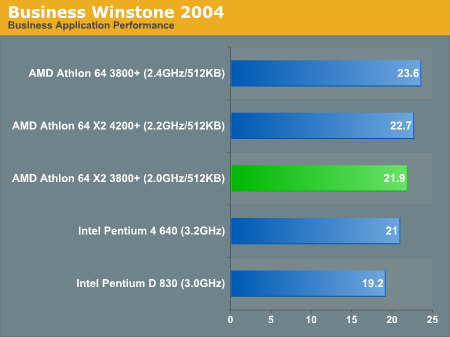
Office Productivity SYSMark 2004
SYSMark's Office Productivity suite consists of three tests, the first of which is the Communication test. The Communication test consists of the following:"The user receives an email in Outlook 2002 that contains a collection of documents in a zip file. The user reviews his email and updates his calendar while VirusScan 7.0 scans the system. The corporate web site is viewed in Internet Explorer 6.0. Finally, Internet Explorer is used to look at samples of the web pages and documents created during the scenario."
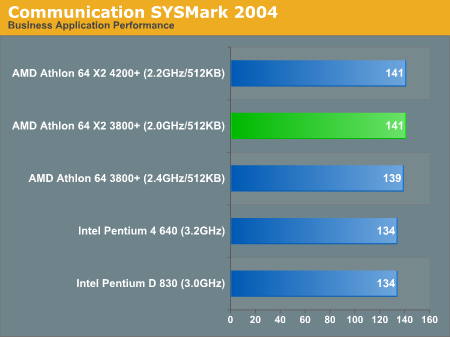
"The user edits the document using Word 2002. He transcribes an audio file into a document using Dragon NaturallySpeaking 6. Once the document has all the necessary pieces in place, the user changes it into a portable format for easy and secure distribution using Acrobat 5.0.5. The user creates a marketing presentation in PowerPoint 2002 and adds elements to a slide show template."
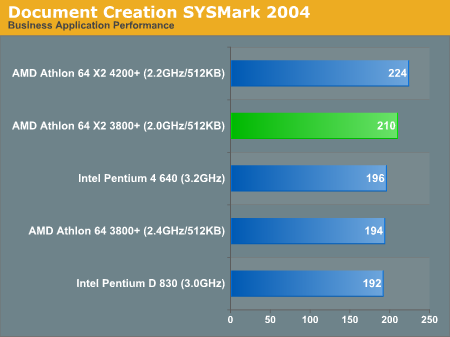
"The user opens a database using Access 2002 and runs some queries. A collection of documents are archived using WinZip 8.1. The queries' results are imported into a spreadsheet using Excel 2002 and are used to generate graphical charts."
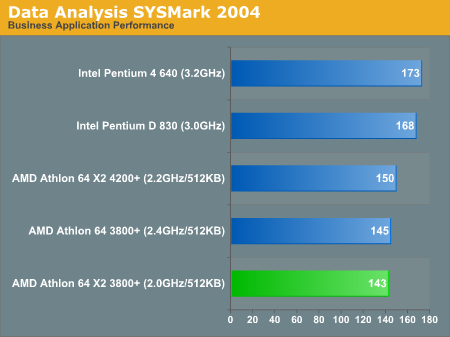
Microsoft Office XP SP-2
Here, we see in that the purest of office application tests, performance doesn't vary all too much. 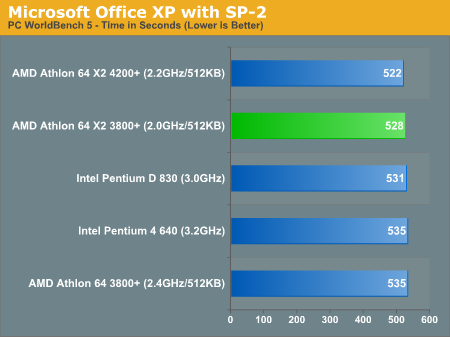
Mozilla 1.4
Quite possibly the most frequently used application on any desktop is the one that we pay the least amount of attention to when it comes to performance. While a bit older than the core that is now used in Firefox, performance in Mozilla is worth looking at as many users are switching from IE to a much more capable browser on the PC - Firefox. 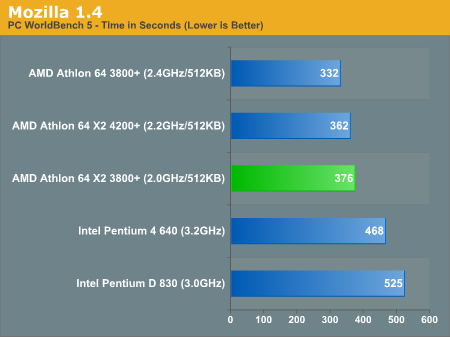
ACD Systems ACDSee PowerPack 5.0
ACDSee is a popular image editing tool that is great for basic image editing options such as batch resizing, rotating, cropping and other such features that are too elementary to justify purchasing something as powerful as Photoshop. There are no extremely complex filters here, just pure batch image processing. 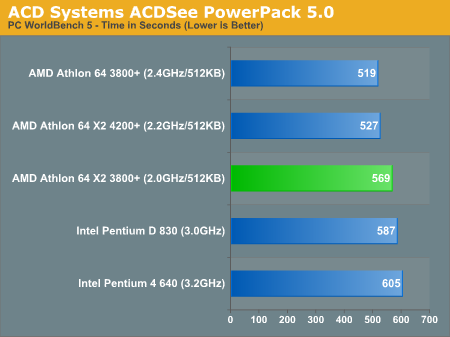
Winzip
Archiving performance ends up being fairly CPU bound as well as I/O limited. 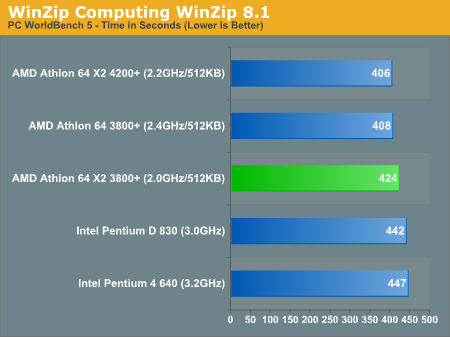
WinRAR 3.40
Pulling the hard disk out of the equation, we can get a much better idea of which processors are truly best suited for file compression. 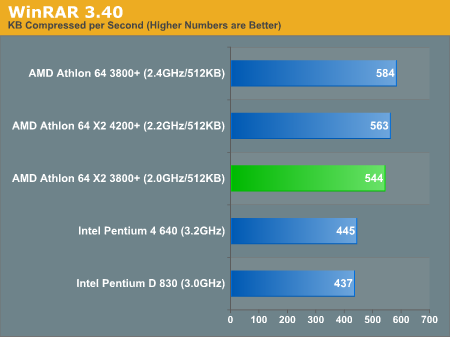










109 Comments
View All Comments
masher - Tuesday, August 2, 2005 - link
> "It is the core itself that increases the cost."True enough-- but a die twice as large shouldn't be over twice the cost...unless your defect rate is pretty high. With a high defect rate, a double-sized die doesn't mean half the yield..it means 1/3 or less.
Intel's dual-core dies are twice as large as their single cores...AMDs are a bit smaller due to the already-embedded HT glue. If the defect rates were anywhere close, then AMD should be able to sell dual-core chips for a smaller premium than Intel. Since they aren't (which likely means can't), we must assume they're still having a fairly high defect rate.
SDA - Tuesday, August 2, 2005 - link
They could also just be charging a premium for the hot new thing. I suspect some of it has to do with AMD wanting to be known as high-end.. when people see Athlons in budget PCs all the time, Athlon becomes associated with budget.Defect rate works too, though. I'm just throwing out other possibilities. Either way, I think we can agree that the CPUs don't cost more because of slick interconnect technology.
krisia - Tuesday, August 2, 2005 - link
Hmmm, hasn't AMD said they've planned for dual core all along and already had tech in their single core chips to support it? So, now they decide to charge for the tech? The thing anand fails to mention is that 40% more money for 10-20% performance gain is not a "clear choice". The choice is much less clear in fact, if you consider you can't buy a X2 3800 yet...SDA - Tuesday, August 2, 2005 - link
40%? The X2 3800+ is supposed to cost $354, but the D 830 is $318 at NewEgg. That looks like a 10% price increase for a 10-20% performance increase AND a cooler processor. Seems like a fairly easy decision to me.If you are suggesting that the inability to perform basic arithmetic is a reason to get the Pentium D, I concur. ;)
krisia - Tuesday, August 2, 2005 - link
If you did the math, then you'd know I was referring to the entry price for the D820. Which is the value entry into dual core? No?SDA - Tuesday, August 2, 2005 - link
The AT review deals with the D 830, not the D 820. You used the numbers from the review and made your remark in the comments section of said review, and yet you feel it's obvious that you're referring to an unreviewed product even if you don't explicitly state such?Let's leave that behind us, though. There is a very simple flaw in your comparison: you're comparing SYSTEM performance differences to PROCESSOR price differences. How about comparing the build prices of an X2 3800+ to a comparably equipped (same amount of memory, same non-core components, all of that) D 820 system, then looking at the performance difference?
If you're too lazy to do the math (and in fairness, it's a PITA to add up components just for the sake of an argument) I'll just explain it simply: it's an 8-15% price boost for 10-20% better performance and a considerably cooler-running processor (and thus, if you plan the system properly, a quieter system).
Before you get defensive, I'm not trying to say that your 820 was a poor choice. I'm certain that you made the perfect choice for your situation. However, it is clear that the 3800+ is a good value in its intended niche.
krisia - Tuesday, August 2, 2005 - link
Ok, the OP didn't reference the anandtech article, only the Pentium D lineup.It's just fun sometimes to do the unconventional or unpopular. :)
SDA - Tuesday, August 2, 2005 - link
I bet it is. Just try to think everything out ahead of time so you don't end up unable to counter the last argument against your "unconventional or unpopular" view.Amplifier - Tuesday, August 2, 2005 - link
First!Hacp - Tuesday, August 2, 2005 - link
I just read toms article and it had alot of synthetic benchmarks and very few real world benchmarks............... Except the ones that favor Intel........